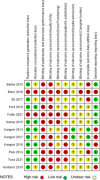Effects of goal-oriented care for adults with multimorbidity: A systematic review and meta-analysis
- PMID: 35355381
- PMCID: PMC9314986
- DOI: 10.1111/jep.13674
Effects of goal-oriented care for adults with multimorbidity: A systematic review and meta-analysis
Abstract
Objective: To systematically review the evidence from randomized controlled trials comparing the effects of goal-oriented care against standard care for multimorbid adults.
Data sources/study setting: The literature presenting the results of randomized trials assessing the outcomes of goal-oriented care compared with usual care for adults with multimorbidity.
Study design: Systematic review and meta-analysis.
Data collection/extraction methods: We searched the Cochrane Database of Systematic Reviews (CENTRAL), EMBASE, MEDLINE, CINHAL, trial registries such as ClinicalTrial.gov and World Health Organization International Clinical Trials Registry Platform (ICTRP), and the references of eligible trials and relevant reviews. Goal-oriented care was defined as an approach that engages patients, establishes personal goals, and sets targets for patients and clinicians to plan a course of action and measure outcome. We reviewed 228 trials, and 12 were included. We extracted outcome data on quality of life, hospital admission, patients' satisfaction, patient and caregiver burden. Risk of bias was assessed and certainty of evidence was evaluated using GRADE.
Principal findings: No study was fully free of bias. No effect was found on quality of life (standardized mean difference [SMD]: 0.05; 95% CI: -0.05 to 0.16) and hospital admission (risk ratio [RR]: 0.87; 95% CI: 0.65 to 1.17). There was a very small effect for patients' satisfaction (SMD: 0.15; 95% CI: 0.00 to 0.29) and caregiver burden (SMD: -0.13; 95% CI: -0.26 to 0.00). Certainty of evidence was low for all outcomes.
Conclusions: No firm conclusions can be reached about the effects of goal-oriented care for multimorbid adults. Future research should overcome the shortcomings of trials assessed in this meta-analysis. Sound application of the indications for research of complex healthcare interventions is warranted.
Keywords: chronic illness; meta-analysis; multimorbidity; primary care; randomized controlled trials.
© 2022 The Authors. Journal of Evaluation in Clinical Practice published by John Wiley & Sons Ltd.
Conflict of interest statement
The authors declare no conflicts of interest.
Figures
References
-
- Wagner EH, Austin BT, Von Korff M. Organizing care for patients with chronic illness. Milbank Q. 1996;74(4):511‐544. - PubMed
-
- Rijken M, Bekkema N. Chronic Disease Management Matrix 2010: results of a survey in ten European countries. Institute for Health Services Research; 2011.
-
- Jackson GL, Powers BJ, Chatterjee R, et al. The patient‐centered medical home: a systematic review. Ann Intern Med. 2013;158(3):169‐178. - PubMed
Publication types
MeSH terms
LinkOut - more resources
Full Text Sources




